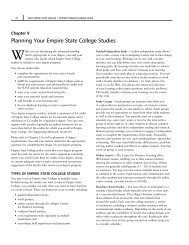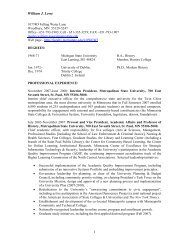All About Mentoring Spring 2011 - SUNY Empire State College
All About Mentoring Spring 2011 - SUNY Empire State College
All About Mentoring Spring 2011 - SUNY Empire State College
You also want an ePaper? Increase the reach of your titles
YUMPU automatically turns print PDFs into web optimized ePapers that Google loves.
62<br />
residences, built by people from the D.F.<br />
(the Federal District, Mexico City), complete<br />
with high walls, lawns and swimming<br />
pools. But they were independent units.<br />
The housing developments of 2010 were<br />
on a different scale entirely. The more<br />
modest, older ones consisted of attached<br />
houses, sometimes very small ones. From<br />
the heights of El Tenayo, they reminded me<br />
more of Mexican graveyards than housing<br />
developments. The newer developments,<br />
very much under construction this summer,<br />
were on a much grander scale, covering<br />
many acres and surrounded by high walls<br />
that could stretch for hundreds of yards.<br />
The scale had changed, but the pattern was<br />
familiar: lands that had for generations<br />
been devoted to food production were<br />
transformed into vacation retreats, complete<br />
with all of the amenities. And local people,<br />
who had once farmed the land, were<br />
allowed through the guarded entrances only<br />
if they had a job to do.<br />
So Mexico’s population continues to grow,<br />
increasing pressure on every resource and<br />
government service, but the fact that the<br />
pace of growth has sharply declined is very<br />
important, and heartening. Why this change<br />
has occurred has, inevitably, prompted much<br />
speculation. The most convincing analysis<br />
I’ve encountered involves the changing<br />
roles of women. Back in the ’70s, Mexico<br />
was a bastion of “machismo.” Women,<br />
especially poor women, had very little say<br />
in most matters, including family planning.<br />
Women, again especially poor and rural<br />
ones, tended to marry early and bear many<br />
children. The expectation was that some<br />
would die, others would move away, and<br />
the parents saw those who remained both<br />
as contributors to the family income and<br />
as their only source of security in old age.<br />
In the intervening years, several things had<br />
changed. Women’s access to education had<br />
improved. Many worked outside the home.<br />
Access to birth control information and<br />
methods had dramatically improved. And<br />
the age of women at marriage had increased.<br />
I’m sure that the impact of these changes<br />
varies by class and region, but it seems clear<br />
that important changes have occurred.<br />
Transformation of the<br />
Mexican Economy<br />
In the mid-1970s, Mexico was at the<br />
end of what some think of as its golden<br />
age. The economy had been growing at a<br />
respectable rate since World War II. The<br />
peso was at 12.5 to the dollar, where it had<br />
been for years, and public confidence in the<br />
Partido Revolucionario Institucional’s (PRI)<br />
stewardship of the economy was pretty high.<br />
This didn’t mean that everybody was happy.<br />
Income distribution was grossly inequitable,<br />
and some other countries were growing at<br />
a much faster rate, but the PRI economists<br />
were accomplishing their own goals: the rich<br />
were, after all, getting richer. Beginning in<br />
the 1980s, all of that changed, abruptly and<br />
radically. A boom related to the promise of<br />
oil revenues and easy access to international<br />
capital led to a catastrophic collapse in the<br />
early ’80s as oil prices fell and interest rates<br />
climbed. This left Mexico nearly bankrupt,<br />
with the greatest burden falling on workers<br />
and the newly emergent middle class. Neoliberals<br />
within the PRI then took over,<br />
driving the divestiture of the government’s<br />
industrial and other investments, and<br />
eventually the adoption of the North<br />
American Free Trade Agreement (NAFTA).<br />
Economic nationalism was abruptly replaced<br />
by internationalism. Mexicans were assured<br />
that international investment would flow<br />
into the country, creating new jobs and<br />
lowering the price of consumer goods<br />
while increasing their quality. Mexico’s<br />
economy would be integrated with those of<br />
Canada and the U.S., incomes would rise<br />
and inequalities would fade away. Along<br />
the way, tariffs would be lowered and then<br />
eliminated, borders would open to the free<br />
exchange of goods, and Mexican industries<br />
would be strengthened through healthy<br />
competition. Mexico had, in short, bought<br />
into the Washington consensus.<br />
What actually happened is a long and<br />
complicated story. Here are a few snapshots:<br />
Investments did flow in, but the vast<br />
majority went to North American<br />
subsidiaries and virtually none went<br />
to small, local enterprises (Juan Carlos<br />
Moreno-Brid and Jaime Ros explore this in<br />
detail.) New technology flowed in, too, but<br />
was employed largely in assembly plants<br />
where products were promptly re-exported<br />
with minimal local impact, save through<br />
the creation of some low-wage, low security<br />
assembly-line jobs. What did radically<br />
change in Mexico was access to North<br />
American retailers, most notably fast food<br />
joints and retailers like Walmart. Wealthier<br />
Mexicans gained easy access to North<br />
American consumer goods. Poorer Mexicans<br />
benefitted from greater competition,<br />
especially in the form of imported (and<br />
heavily subsidized) U.S. corn. The very<br />
wealthiest of Mexicans also benefitted, as<br />
did their colleagues in Russia, from the<br />
opportunities presented by privatization.<br />
Carlos Slim, one of the world’s wealthiest<br />
men, got a huge boost when he bought up<br />
Mexico’s cell phone services, replacing a<br />
public monopoly with a private one. The<br />
national economy did not achieve “takeoff.”<br />
The promise of integration with the<br />
“Colossus of the North” did not extend to<br />
people. And the PRI government lost the last<br />
shreds of its credibility as a manager of<br />
the economy.<br />
Walmart is there … but<br />
its local competitors are<br />
as big – and as offensive.<br />
When we left Mexico in 1975, I took a look<br />
around the Yautepec open-air market and<br />
wondered if it would still be there when I<br />
returned. There were, at that time, a few<br />
grocery stores in Mexico, and I wondered<br />
whether the North Americanization of<br />
the Mexican food system would put the<br />
public markets out of business. That hasn’t<br />
happened. What you see in Mexico today<br />
are two systems existing in parallel. In<br />
both Cuernavaca and Yautepec, the local<br />
public markets are alive and well. They<br />
look much the way they did when I left:<br />
full of great smells and colors, populated by<br />
local vendors selling meat and vegetables<br />
that have never experienced the inside of a<br />
refrigerator, and visited by local people who<br />
appreciate the social as much as the practical<br />
aspects of buying food. But now a fully<br />
articulated parallel system exists, complete<br />
with parking lots, air conditioning, and the<br />
suny empire state college • all about mentoring • issue 39 • spring <strong>2011</strong>

















